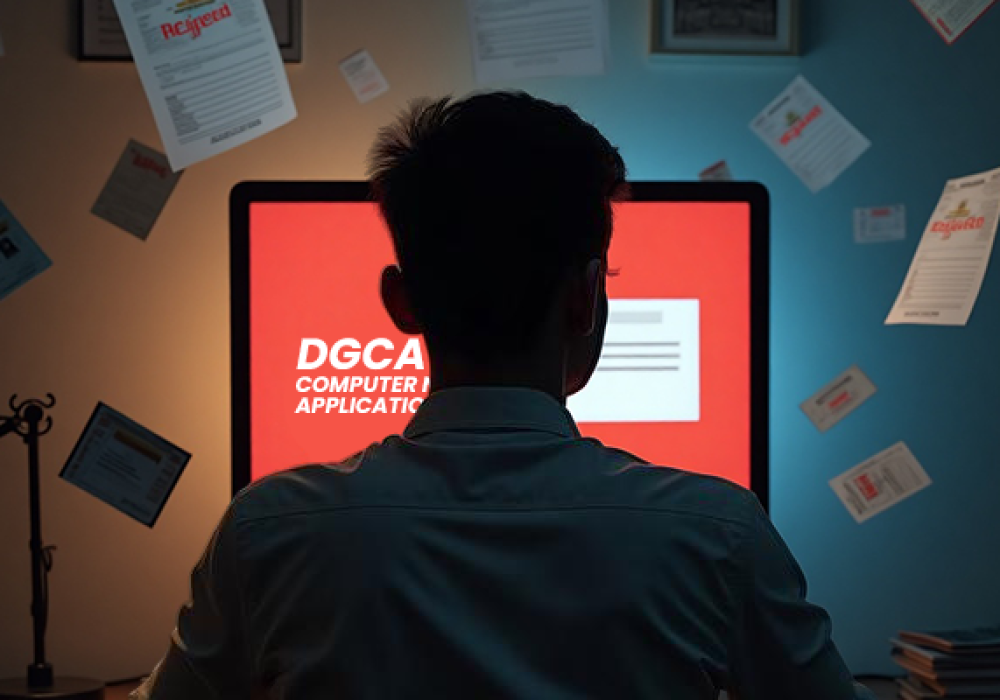The Directorate General of Civil Aviation (DGCA) Computer Number serves as a crucial identifier for aspiring pilots in India, yet many applications face rejection due to various procedural and documentation issues. This comprehensive analysis examines the primary reasons behind DGCA Computer Number application rejections and provides evidence-based strategies to ensure successful approval on the first attempt.
5 Common Reasons
- Name Discrepancies and Certificate Inconsistencies
- Improper Document Attestation
- Photograph and Signature Requirements
- Board Verification Certificate Issues
- Educational Qualification Compliance
Name Discrepancies and Certificate Inconsistencies
One of the most prevalent causes of DGCA Computer Number application rejection involves name inconsistencies across various documents. The rejection records reveal numerous cases where applicants' names in their applications do not match their 10th board certificates. When applicants hold Commercial Pilot Licenses (CPL) or Student Pilot Licenses (SPL) that contain names different from their educational certificates, the DGCA requires either correction by the issuing authority or submission of an original affidavit to the DGCA.
These strict naming requirements ensure proper identity verification and regulatory compliance throughout the pilot's career.
Improper Document Attestation
Document attestation represents another significant area where applications frequently fail. The rejection records consistently show issues with "Improper attestation of photograph" and "Improper attestation of supporting documents". Proper attestation requires that all documents be signed by a Class 1 gazetted officer, and any deviation from this requirement results in immediate rejection. The attestation process serves as a crucial verification step, ensuring document authenticity and preventing fraudulent submissions.
The complexity of attestation requirements extends to specific formatting and procedural aspects. Applications are rejected when photographs are pasted over specimen signatures, when attestation certificates are incomplete, or when the attestation does not follow prescribed formats. These stringent requirements reflect the DGCA's commitment to maintaining high standards of documentation and preventing any potential misrepresentation in pilot credentials.
Photograph and Signature Requirements
Photograph-related rejections constitute a substantial portion of application failures, primarily due to non-compliance with strict technical specifications. The DGCA requires photographs with specific dimensions, white backgrounds, and matte finishes. Applications are rejected when photographs fail to meet these standards or when they are improperly positioned within the application form.
The signature requirements are equally stringent, with specific size parameters detailed in the user manual. Many applications face rejection because signatures are not placed in designated boxes or fail to meet clarity standards
Beyond basic specification compliance, applicants frequently encounter rejection due to technical execution errors. These include using blue ink instead of the required black ink for signatures, inadequate scanning resolution, and poor image quality that renders documents illegible. The digital submission process requires specific file formats and size limitations, and failure to adhere to these technical requirements results in automatic rejection.
Board Verification Certificate Issues
Board Verification Certificate (BVC) requirements represent a critical area where many applications encounter difficulties. The DGCA mandates BVC for 10th and 12th standard marksheets, particularly ensuring that 12th standard includes Mathematics and Physics subjects. Applications lacking proper board verification or containing unverified educational credentials face immediate rejection.
The board verification process varies significantly across different educational boards, with CBSE and ICSE offering online verification while regional state boards maintain their own procedures. Applicants must navigate these varying requirements carefully, ensuring that their specific educational board's verification process is completed before application submission. The complexity of this requirement often leads to delays and rejections when applicants underestimate the time and effort required for proper verification.
Educational Qualification Compliance
Beyond basic verification, applications must demonstrate compliance with specific educational requirements outlined in Civil Aviation Requirements (CAR). The DGCA requires proof of completion of 10+2 education with Mathematics and Physics, and any deviation from these subject requirements results in rejection.
Prevention Strategies & Best Practices
Basic Step
Applicants should thoroughly review the Pariksha User Manual and ensure all documents meet specified requirements.(if the file is not available, please visit Pariksha’s Official Website and look for User Manual in the Navigation Menu and select Flight Crew Manual).
Preparation Before Applying
Successful Computer Number application requires comprehensive preparation before submission. This includes obtaining proper board verification certificates, preparing photographs and signatures according to exact specifications, and ensuring all names match precisely across all documents.
Understanding the specific CAR requirements applicable to the intended license category can prevent eligibility-related rejections and ensure appropriate application categorization.
Document Review
Double-check all name spellings, ensuring document clarity and legibility, and verify that all attestations follow prescribed formats, for detailed information check the page 6 to page 11 of Pariksha User Manual
Professional Assistance
Wing Path offers professional assistance from experienced aviation consultants who will provide valuable guidance in navigating complex requirements to obtain your DGCA Computer Number. However, applicants remain ultimately responsible for ensuring accuracy and completeness of their submissions, regardless of assistance received.
Summary
DGCA Computer Number application rejections stem from a complex interplay of documentation, technical, and regulatory compliance issues. The most common causes include name discrepancies across documents, improper attestation procedures, photograph and signature specification failures, and eligibility-related complications.
While the introduction of the partial rejection system has improved the correction process, prevention through careful preparation remains the most effective strategy.
Success in obtaining DGCA Computer Number approval requires meticulous attention to detail, comprehensive understanding of regulatory requirements, and systematic preparation of all required documentation.
Applicants who invest time in understanding these requirements and implementing proper quality control measures significantly increase their chances of first-attempt approval, avoiding the delays and complications associated with rejection and resubmission processes.
Disclaimer:
This article is intended for informational purposes only and does not constitute legal or regulatory advice. While every effort has been made to ensure accuracy, applicants are advised to refer to the official DGCA Pariksha portal and consult authorized professionals or aviation training institutions for guidance tailored to their specific cases. Wing Path and the authors are not responsible for any outcomes resulting from misinterpretation or misapplication of the information provided.









